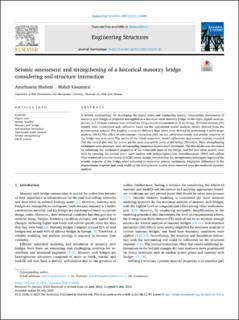Seismic assessment and strengthening of a historical masonry bridge considering soil-structure interaction
Peer reviewed, Journal article
Published version
Permanent lenke
https://hdl.handle.net/11250/3104208Utgivelsesdato
2023Metadata
Vis full innførselSamlinger
Sammendrag
A holistic methodology for developing the digital twins and conducting seismic vulnerability assessments of masonry arch bridges is proposed and applied to a historical stone masonry bridge. In this light, digital cameras, drones, and 3D laser scanners were utilized for 3D geometric documentation of the bridge. 3D finite element (FE) models were constructed and calibrated based on the operational modal analysis results derived from the accelerometer sensors. The fragility curves for different limit states were derived by performing a multi-stripe analysis (MSA). The effect of soil-structure interaction (SSI) on the calibration results and seismic response of the bridge was evaluated. The results of the visual inspection, model calibration, and seismic analysis revealed that the central pier and the arches are the most susceptible parts of the bridge. Therefore, three strengthening techniques were proposed, and corresponding numerical models were developed. The first model was developed by enhancing the mechanical properties of the vulnerable parts of the bridge, and the two other models were built by covering the central pier’s outer surface with polyparaphenylene benzobisoxazole (PBO) and carbon fiber-reinforced concrete mortar (FRCM) layers. Results revealed that the strengthening techniques improved the seismic response of the bridge when subjected to transverse seismic excitations. Negligible differences in the displacement response and crack width of the strengthened models were observed from the nonlinear dynamic analysis.

